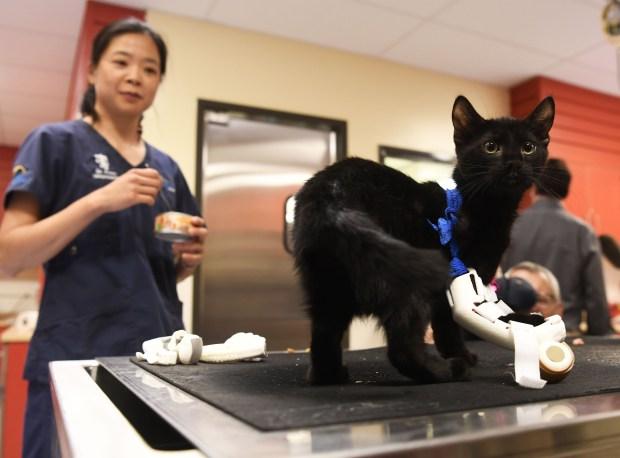
I admit it – I’m a sucker for a good kitten story. (Who isn’t, really?) We’ve seen several kittens who have been helped by 3D printed prosthetics or assistive devices before – Tiny Tim was the most recent kitten recipient of a 3D printed wheelchair, but before him there were Cassidy and Benji, who were also given 3D printed wheels. It’s not all putting kitties on wheels, though – there have also been several instances of 3D printing used to create effective prosthetic legs for cats. That’s the goal for Sonic and his team of designers and surgeons – to get him walking on four legs with a little 3D printed help.
According to Dr. Louisa Poon at the Denver Animal Shelter, a cat with a deformity like Sonic’s would normally have a few options, but none of them would be very promising. Amputation would be the most likely route, and while cats can adapt quite well to a missing limb, it’s a major liability for a shelter cat. Animals with disabilities or deformities are much less likely to be adopted, and that, sadly, often leads to euthanasia. 3D printed prosthetics can literally be lifesavers in these cases.
Designing a prosthetic for a kitten presents particular challenges, as they grow so quickly that it’s hard to keep up. The Art Institute started working with Sonic nine weeks ago, and they’ve already gone through five models. According to Professor Gregg Harvey and design and technical graphics student Salim Fermin, it takes about four days to produce a new prosthetic, but the time and effort are worth it as Sonic begins to slowly adapt. The device may look awkward right now, but the final one, which the designers estimate can be printed in two or three months once the kitten reaches his full size, will be very different.
“As we’re starting to understand how his mechanics move, we’ll develop more and eventually have a lighter material,” Harvey said. “At the end of this, we’ll have a very exotic final product that will fit perfectly to him. This is about getting to apply design skills to somehow better the world. Animals are innocent — if we can somehow help Sonic, we’re doing a good thing.”
The final device, according to Dr. Poon, will be made of carbon fiber rather than plastic. The kitten has definitely been making progress with the prototypes, which shows a lot of promise for his ability to eventually walk normally.
“I think he has quite a bit of spirit. He’s quite resilient and doesn’t realize his limitations until he jumps and lands on his leg,” said Harvey. “The end goal is to create a prosthetic as close to the real limb as possible.”
While the Sonic Project may have been named for him, “Sonic the Bionic” is only the first animal that Denver Animal Shelter and the Art Institute of Colorado hope to help with 3D printed prosthetics. The partnership will be an ongoing thing as other animals in need present themselves. Creating a prosthetic device for an animal is more challenging than for a human, according to Harvey, as a kitten can’t give feedback on how the device feels, so dedicated groups like this one are vital. The technology is there, but injured and deformed animals can’t be helped without humans who are willing to put in the time and hard work to circumvent the challenges.
Sonic himself is currently in foster care, but he’ll be up for adoption very soon, so if you’re in the Denver area and interested in helping a special-needs kitty have a good life, keep an eye on the shelter’s website! What do you think of Sonic’s new lease on life? Discuss further in the Kitten Receives 3D Printed Leg forum over at 3DPB.com.
[Source: Denver Post]